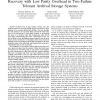Free Online Productivity Tools
i2Speak
i2Symbol
i2OCR
iTex2Img
iWeb2Print
iWeb2Shot
i2Type
iPdf2Split
iPdf2Merge
i2Bopomofo
i2Arabic
i2Style
i2Image
i2PDF
iLatex2Rtf
Sci2ools
PRDC
2015
IEEE
2015
IEEE
Combining Low IO-Operations During Data Recovery with Low Parity Overhead in Two-Failure Tolerant Archival Storage Systems
—Archival data storage systems contain data that must be preserved over long periods of time but which are often unlikely to be accessed during their lifetime. The best strategy for such systems is to keep their disks powered-off unless they have to be powered up to access their contents, to reconstruct lost data, or to perform other disk maintenance tasks. Of all such tasks, reconstructing data after a disk failure is the one that is likely to have the highest energy footprint and the most impact on the overall power consumption of the array, because it typically involves powering up all the disks belonging to the same reliability stripe as the failed disk and keeping them running for considerable time at each occurrence. We investigate two two-failure tolerant disk layouts that have lower parity overhead than the number of disks read (and hence powered-on) for recovering data on lost drives would suggest. Our first organization is a flat XOR code that organizes the data disks int...
| Added | 16 Apr 2016 |
| Updated | 16 Apr 2016 |
| Type | Journal |
| Year | 2015 |
| Where | PRDC |
| Authors | Thomas J. E. Schwarz, Ahmed Amer, Jehan-François Pâris |
Comments (0)

